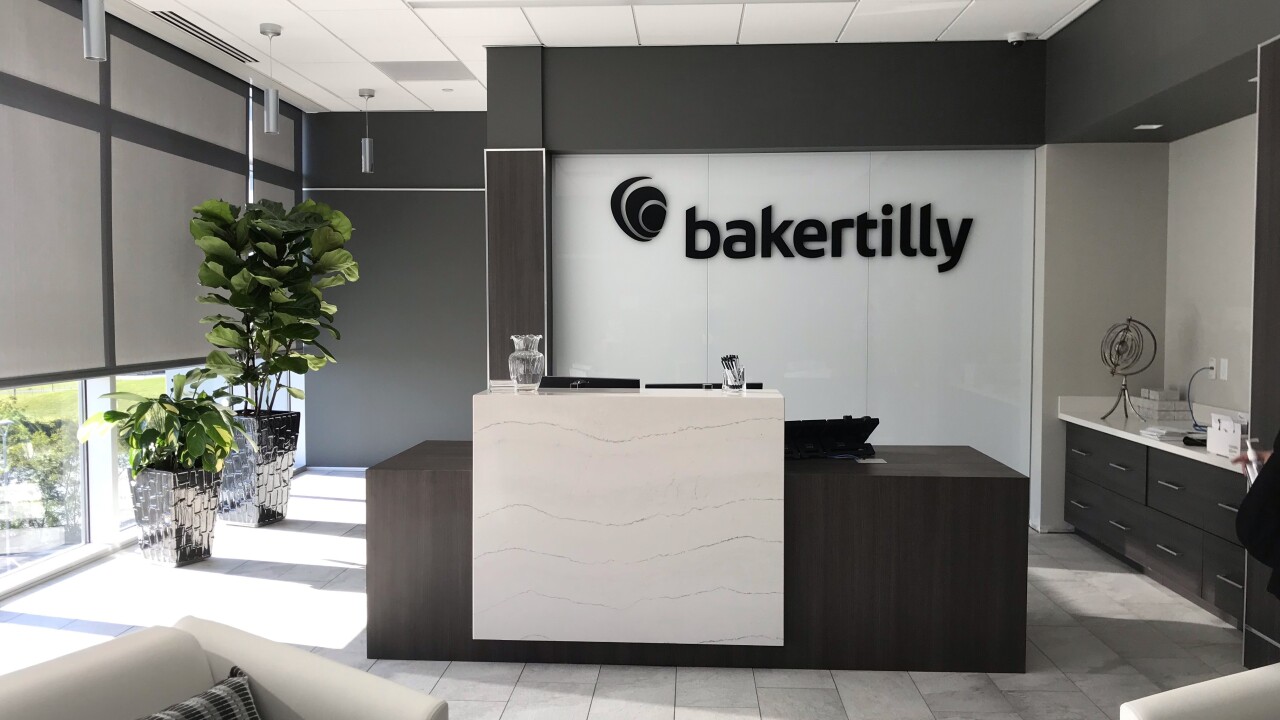1. Between 2002 and mid 2008, CPA firms enjoyed one of the biggest booms in the professions history. Business was so good that most firms stopped proactive marketing because they couldnt handle any more business.
The trigger and the fuel for this so-called "golden age" came from the U.S. government in the form of the Sarbanes-Oxley Act. The act created a type of "watchdog" role for CPA firms, leading to trillions of revenue dollars for the Top 100 firms and trillions more for smaller firms that took on the small clients that the large firms could no longer service.
Can more government-sponsored legislation be around the corner? Who will be the watchdogs over the TARP and other bailout money? The U.S government cant do it, that's for sure. The obvious choice is the CPA profession. Its inevitable that new laws and oversight regulations will evolve, and the CPA profession should stand to benefit once again.
2. The old expression, "Is the glass half full or half empty?" applies well to the recession's impact on CPA firms. "Half-empty" firms are cutting back on marketing; staying loyal to the same under-appreciative, dead-end clients; laying off staff; reducing fees; cutting expenses and doing a lot of praying. The "half-full" crowd looks at the problem (the recession) and sees opportunities. They are moving their client base upscale by taking advantage of the downstream flight from larger firms by smaller clients in pursuit of lower fees. They are upgrading their staff level, taking advantage of the best market for experienced staff in 20 years. They're spending more, not less, money on marketing because they recognize that, more than ever before, they need to proactively seek new business. They are searching for mergers because smaller firms are feeling even more vulnerable than they did during the boom times. They are doing more consulting work because, in a recession, clients need help weathering the storm.
3. After a decade or so of decline, careers for CPAs are once again hot for many reasons:
· Accounting has always been a stable career, even during a recession.
· Earnings for CPAs have always been near the top of the pay scale compared to other jobs. This applies to entry-level jobs ($45,000-$60,000), experienced staff positions ($80,000-$150,000) and the ownership ranks (national average of partner earnings is $369,000). All of these positions are higher paid than 95 percent of other jobs.
· Contrary to the stereotype, the career of a CPA is far from boring. When the U.S. was asking CPA firms to prevent another Enron or WorldCom failure, young people paid attention. When, as I predict, CPA firms play a key role as the government's watchdog over TARP and bailout money, young people will again take notice and become increasingly interested in accounting as a career.
· With thousands of baby-boomer partners in pre-retirement mode, opportunities for young people to rapidly become owners of firms are terrific.
· Emphasis placed on work-life balance at most firms has dulled the ages-old (and richly deserved) perception that working at a CPA firm is like a sweatshop.
· There are tremendous opportunities for women and minorities, both of whom are woefully under-represented in the partner ranks at firms across the country.
4. The CPA industry is now looking at the best labor market in recent memory, certainly for the last 20 years. This has been triggered by:
· Increased enrollment by undergrad students in accounting.
· SOX work running out of steam, dramatically reducing the hiring of young staff by the Top 50 firms.
· The recession, which has caused most firms to lay off substantial amounts of people.
5. Overshadowed by the recession, the storming of Washington by Obama, and the TARP/bailout events, mergers and succession planning continue to be the huge issues that mainstream CPA firms grapple with.
The percentage of CPA firm partners over the age of 50 has risen from 49 percent in 2005 to 53 percent in 2006 to 57 percent in 2007. It won't be long until 60 percent or more of all partners are over 50. And despite the very slight relaxation of the staffing crisis, most firms continue to lack staff with partner potential to take their place. Merger is the only exit strategy for thousands and thousands of firms. The recession should only exacerbate the need for mergers. Smaller firms are particularly vulnerable as their clientsmostly small, privately owned companies being hit hard by the economic slowdownlook to cut costs and delay expenditures. In addition, the smaller firms' lack of marketing skills will make it very difficult for them to replace clients lost to the recession.
Three additional factors impact this picture:
· Many firms are afraid to pull the trigger on mergers, fearing that life as they've known it will cease to exist. Most "smaller" firms have the inaccurate perception that mergers don't work.
· Many partners who were thinking of retiring in the next 1-3 years will be putting retirement off because a huge portion of their retirement money was lost in the stock market crash of 2008-2009.
· Smaller firms that know their marketing limitations will be more likely to aggressively pursue growth via merger, possibly bidding up the price that buyers are willing to pay.
6. The movement away from formulas toward performance-based, judgmental systems for allocating partner income continues to pick up steam. The term book of business has suffered a stroke that will prevent this metrics ability from ever reclaiming its long-held title as king of the income allocation factors.
7. The expression "fat and happy" often applies to affluent organizations that enjoy a multi-year run of record success. This has particularly applied to CPA firms in recent years.
Examples:
· Lack of marketing effort by partners was overlooked.
· Low levels of billable hours by staff were accepted because firms incorrectly assumed that if they raised productivity expectations, the staff would leave, something that was considered unconscionable in the tightest labor market in history.
· Unproductive partners weren't dealt with because there was plenty of money to go around.
· Related to the item above, partner accountability continued at low levels because firms didn't want the resulting conflict during times when earnings were sky high.
· Changes to more technologically advanced IT systems were put off because partners reasoned, "Why fix something that isn't broken?"
· Strategic planning was done lackadaisically because firms reasoned, either consciously or subconsciously, that the only real strategy they needed was to keep doing what they have been doing and make lots of money.
Due to the recession, firms will be forced to trim the fat, which will be a good thing.
8. Bigger is better. If you graph the income per partner of firms, from low fee levels to high, the result is an upward slope (except for one "bump", discussed below). This obviously doesn't guarantee that if a firm increases its top line, its bottom line will follow, because poor management can easily negate strong fundamentals. But if firms combine strong top-line growth with just average management, they almost always post stronger earnings.
This combination, or the lack of it, has resulted in huge gaps in almost all key performance metrics between larger firms (say, over $10 million and $20 million in annual fees) and smaller firms (say, firms of $2 million to $5 million and firms of under $2 million). I call this the "haves" and the "have-nots." I'm convinced that the major contributor to these gaps is not marketing success, quality of staff, quality of clients, cost controls or any other of a number of factors. But the one factor that does differentiate the "haves" from the "have nots" is strong, effective management.
9. When we look at the profitability of firms of increasing size ranges, it's clear there is a "speed bump" at the $6 million to $10 million range:
Annual Fees Income per Partner
$2 million - $4 million $288,000
$4 million - $6 million $369,000
$6 million - $10 million $352,000
$10 million - $20 million $429,000
In the $6 million to $10 million range, firms find that the old ways of doing things no longer work. These firms find that to continue their success, they need to be run like a real business instead of a group of non-accountable Lone Ranger partners sharing staff and overhead under one roof. I have created what I call the "watch list" for firms either approaching the $6 million figure or already in the $6 million to $10 million range. There is a long list of things that will need to improve. Examples include partner accountability; corporate style management; strategic planning and goal setting; hiring professionals to manage the internal administration, marketing, IT and HR areas; changing partner comp systems to move away from formulas; teamwork; and making the firm a great place to work that proactively trains staff in leadership.
10. A career in public accounting is one of the best career choices a person can make. The focus is on helping people (clients and staff) succeed. The work blends creativity with technically demanding expertise. Ample use of technology reduces the drudgery. Opportunities to give back to the community abound. Few jobs pay better than that of a CPA firm partner. All in all, it's a great formula for a richly rewarding professional life.





